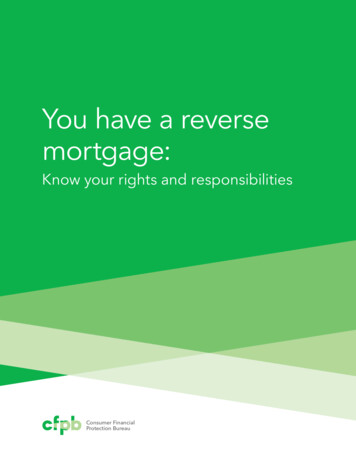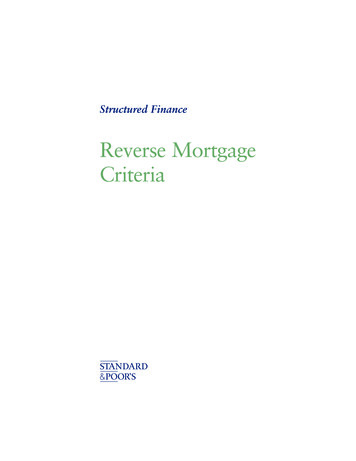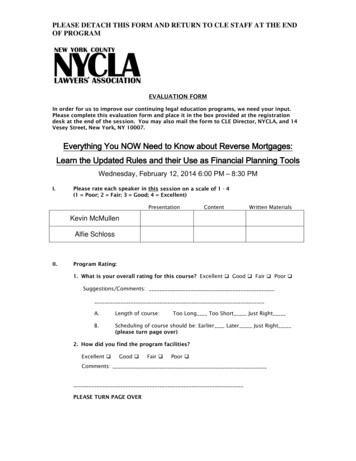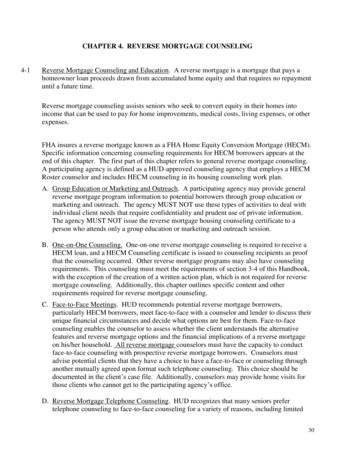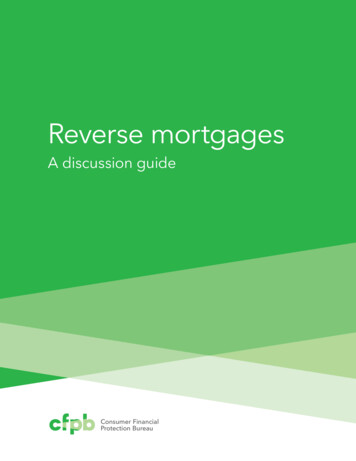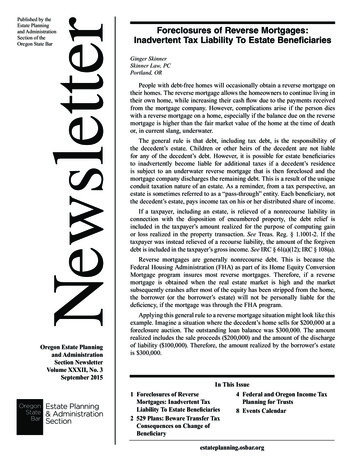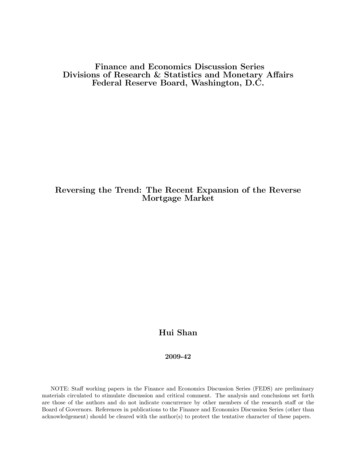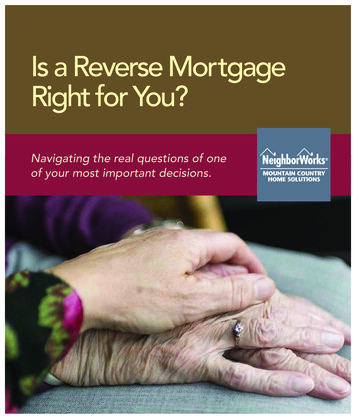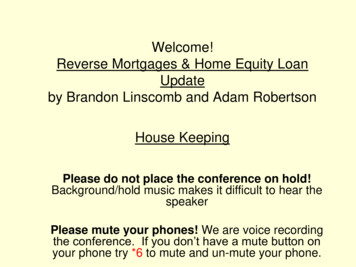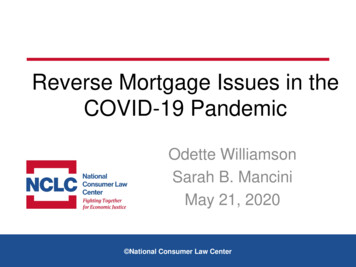
Transcription
Reverse Mortgage Issues in theCOVID-19 PandemicOdette WilliamsonSarah B. ManciniMay 21, 2020 National Consumer Law Center
NCLC CARES ActWebinar Series COVID-19 and Mortgage Relief forHomeowners Forbearance Options and CARES ActRequirements Reverse Mortgage Issues in the COVID19 Pandemic An Overview of Post-Forbearance Options May 28th2
NCLC’s MortgageTraining ConferenceJune 15-17, 2020 Intro to TILA/RESPA Servicing Claims COVID-19 Mortgage Relief: Forbearance andLoan Mod Options for Federally BackedMortgages Home Equity Theft and Foreclosure RescueScams 101 Home Purchase Scams: Investigation, FundingStructure, Claims and Defenses FCRA Issues in Mortgage Cases Multi-Servicer Cases Strategic Advocacy on Home Scams: Workingwith Local Government, Effective Outreach3
Overview Foreclosure moratorium in the CARES Act, asextended by HUD Non-borrowing spouse and MOE issues “Forbearance” for HECMs under the CARES Act New property charge defaults Existing Repayment Plans and At-Risk Extensions* Note: a quickly shifting landscape; Watch forupdates in email blasts.4
Reverse Mortgage Basics5
Reverse Mortgage Basics FHA-Insured Reverse Mortgages: the HomeEquity Conversion Mortgage (HECM); borrowermust be at least 62 years old Proceeds may be taken as a lump sum, line ofcredit, or an annuity No monthly payments of principal or interest;interest and servicing fee is added to the loanbalance each month Loan comes due upon a triggering event –death or non-occupancy6
Reverse Mortgage BasicsRegular/Forward MortgageReverse Mortgage250250LoanBalanceLoanBalance00TimeTime7
Reverse Mortgage Basics Loan balance may grow to exceed the valueof the house FHA insurance Nonrecourse loan Initial principal amount loaned is based on: Appraised value of the house Prevailing interest rates Age of the youngest borrower (older higher loan proceeds)8
Maximum Claim AmountThe lesser of: Appraised value of the houseOR 726,5259
Property ChargesThe reverse mortgage borrower must continue tocover “property charges,” including: Property taxes Homeowner’s insurance HOA and other fees10
“Due and Payable” Events The last surviving borrower dies The last surviving borrower sells the home orconveys title (however, borrowers can convey titleafter closing as long as they retain at least a lifeestate interest in the property) The borrower changes their principal residence A borrower may be away from the home for up to12 months if the absence is due to medicalreasons. Borrower fails to pay property charges or maintainthe property in “saleable” condition11
HECM Policies Statute: 12 U.S.C. § 1715z-20 HUD Regulations: 24 C.F.R. Part 206 HECM Final Rule: 82 Fed. Reg. 7094(effective September 19, 2017) RedlineCopy Mortgagee Letters HECM Handbook 4235.1 FAQs12
CARES Act Moratorium andRecent Extension13
CARES Act Coronavirus Aid, Relief, and EconomicSecurity Act, Pub. L. No. 116-136 Link to the CARES Act (NCLC summary) Provides two types of relief to borrowerswith federally backed mortgage loans: Foreclosure moratorium Forbearance Section 4022 of the CARES Act14
CARES Act Federally backed mortgage loans any loan which is secured by a first or subordinatelien on residential real property (includingindividual units of condominiums andcooperatives) designed principally for the occupancy of 1- to 4families that is owned or backed by a federal agency Fannie Mae, Freddie Mac, FHA, USDA, VA15
CARES Act ForeclosureMoratorium Foreclosure Moratorium servicer of a federally backed mortgage loan may not initiate any judicial or non-judicialforeclosure process, move for a foreclosure judgment or order of sale, or execute a foreclosure-related eviction orforeclosure sale for not less than the 60-dayperiod beginning on March 18, 2020 Except for vacant or abandoned properties Ended May 17, 202016
HUD Moratorium For FHA-insured single family mortgages coveredunder the CARES Act ML 2020-04 (March 18, 2020) 60 day foreclosure and eviction moratorium forforward and reverse mortgages Initiation and completion of foreclosures in process Deadlines for initiating foreclosure and reasonablediligence deadlines extended 60 days ML 2020-13 (May 14, 2020) June 30, 2020 Except for vacant or abandoned properties Deadlines extended 90 days17
CARES Act Forbearance Forbearance – temporary suspension of therequirement to make mortgage payments Interest will still accrue, but not late fees andthe borrower is not considered in breach ofthe contract Borrower will be reported as current if he orshe was current before the forbearanceperiod18
CARES Act Forbearance A borrower with a federally backed mortgageloan experiencing a financial hardship due,directly or indirectly, to the COVID–19 mayrequest forbearance by— (A) submitting a request to the servicer; and (B) affirming that the borrower is experiencing afinancial hardship Request forbearance regardless ofdelinquency status19
CARES Act ForbearanceCovered period Not defined in § 4022 In § 4023 for multifamily forbearance: the period beginning on the date of enactment ofthis Act (3/27/2020) and ending on the soonerof— (A) the termination date of the national emergencyconcerning the novel coronavirus disease (COVID–19)outbreak declared by the President on March 13, 2020under the National Emergencies Act (50 U.S.C. 1601 etseq.); or (B) December 31, 2020.20
CARES Act Forbearance Upon a request by a borrower forforbearance, such forbearance shall be granted for up to180 days, and shall be extended for anadditional period of up to 180 days at therequest of the borrower, provided that, at theborrower’s request, either the initial orextended period of forbearance may beshortened One year of relief21
CARES Act Forbearance Servicer’s Requirements: Upon receiving a request for forbearance: No additional documentation required other thanthe borrower’s attestation to a financial hardshipcaused by the COVID–19 emergency No fees, penalties, or interest (beyond theamounts scheduled or calculated as if the borrowermade all contractual payments on time and in fullunder the terms of the mortgage contract) chargedto the borrower in connection with the forbearance,22
HUD COVID-19 Extension Period ML 2020-06 (April 1, 2020) 6 month extension additional 6 month with approval Delay calling loan due and payable upon requestof borrower Must waive any late charges, fees and penalties Loans automatically due and payable, in deferral,or become due and payable with HUD approval Automatically extend foreclosure deadlines anddeadlines for lenders to file a claim with HUD No documentation requirement23
Deadlines Foreclosure Process Notice to HUD of due and payable status Notice to borrower or heirs of due andpayable status Notice to HUD of the initiation of foreclosure Sale of home, deed in lieu, payoff Cure of conditions which cause the loan tobecome due and payable Foreclosure/ post foreclosure disposition ofproperty24
HUD COVID-19 Extension Period Automatically upon request from borrower Occupancy no longer principal residence Elder in health care facility Property charges/ MOE – more later Emailed or verbal certification of occupancy Approve COVID extension up till October 30,202025
NON-BORROWING SPOUSES26
The Problem Until Aug. 2014, reverse mortgages only protected theborrower from foreclosure, even if there was a nonborrowing spouse (NBS). Lenders regularly removed a (younger) spouse from adeed when closing a HECM because: The younger spouse is not yet 62; Higher loan proceeds (and origination fees) if removeyounger spouse. Although HECM brokers often told non-borrowingspouse they could be added back onto the deed later,loan docs called the loan due and payable upon thedeath of the borrower.27
Addressing the Problem Litigation - Bennett v. Donovan, 703 F.3d582 (D.C. Cir. 2013) and other cases. On June 12, 2015, HUD issued ML 201515, giving servicers the option to assignthe loan to HUD. Problematic deadlines blocked access formany non-borrowing spouses.28
Mortgagee Letter 2019-15:MOE - NEW version (3.0) Effective 9/23/19 Like prior MOE, gives servicers the option to assign theloan to HUD and allow eligible spouse to remain in thehome. Prior version, ML 2015-15: Had strict deadlines and requirements that made it difficult formany spouses and servicers to comply Many problems, many denials, and a lot of advocacy led to newpolicy IMPORTANT: Spouses denied under the priorMOE have a new window for the loan to beassigned to HUD (within 6 months of ML 2019-15)if servicer hasn’t already foreclosed. This includes spouses who received “in house” MOE’s from theirservicer.29
New Window for MOEAssignments Extended New “reasonable diligence” windowrunning six months from the later of theborrower’s death or issuance of ML 201915 on 9/23/19 3/21/2020 Covid-19 emergency began in mid March ML 2020-06 extends the MOE “reasonablediligence” window by an additional 6months 9/21/202030
New Window for MOEAssignments Extended See Mortgagee Letter 2020-06, page 7 (“ the Mortgagee may take an automaticextension of any deadline relating toforeclosure and claim submission for a periodof up to 6 months”) HUD clarified that this includes extension ofthe MOE “reasonable diligence” window in awebinar (slide 11) https://www.hud.gov/sites/dfiles/SFH/documents/fha updated guidance HECM covid 19 4 22 20.pdf31
NBS Deferral Period: Post-2014 Loans Loans made after 8/4/14 are required toinclude a deferral period for an eligible NBS(identified at the time of origination). Theseloans don’t need the MOE. Emerging problems: Servicers ignoring deferral period altogether Initiating foreclosure if spouse doesn’t respondwithin 30 days of the borrower’s death Requiring proof of “good and marketable title” beprovided within 90 days of the death Be on the lookout for these issues, and contactNCLC about problems32
Property Charge Defaults33
Obligation to Pay PropertyCharges “Timely” Property charges, 24 CFR 206.205(e)(2) If the borrower fails to pay property charges in atimely manner Mortgagee shall provide a written notification tothe borrower and HUD within 30 days of themissed payment; borrower shall have 30 days to respond; servicer may provide loss mit; if borrower unable or unwilling to repay theservicer advance, mortgagee shall submit a dueand payable request to HUD.34
Property Charges Due During theState of Emergency Some localities have extended the duedate for property taxes that came dueduring the state of emergency HUD considers taxes to be “current” whenthey are paid prior to delinquency asdefined by the local taxing authority (forpurposes of claim type 22 assignmentrequests arguably should apply here too) Mortgagee Letter 2018-08 (Oct. 22, 2018)35
Property Charges Due During theState of Emergency Communicate with the servicer if thetaxing authority has granted a broadextension or an individual extension/graceperiod Help the borrower plan for how they willpay the taxes by the end of the extension Be prepared that servicers may advancethe taxes anyway. Please tell NCLC if thishappens.36
Property Charge ForeclosureDEFAULT OCCURSDUE AND PAYABLEREQUESTINITIATEFORECLOSURE37
Property Charge ForeclosureDEFAULT OCCURSDUE AND PAYABLEREQUESTINITIATEFORECLOSURE38
CARES Act HUD PolicyMortgagee Letter 2020-06:Upon a request from the Borrower, theMortgagee must delay submitting a due andpayable request by up to 6 months; add’l 6month extension may be approved by HUDMortgagee may take an automatic extensionfor any deadline relating to foreclosure andclaim submission for up to 6 months; add’l 6months may be approved by HUD.39
CARES Act HUD Policy Arguably, both delays should bemandatory (not discretionary withservicer) CARES Act says “shall” and“regardless of delinquency status” Even after the loan has been calleddue and payable, if the borrowerrequests a forbearance, the servicershould delay foreclosure HUD says the delay is mandatory ifrequested by a borrower, even afterdue and payable, at slide 13 of thisHUD webinar Escalate if problems arise!40
Available Property ChargeLoss Mitigation Options Repayment plan (Option 1, ML 2015-11) Includes any property charges coming due in next90 days Not include HOA dues Term as long as 60 months, unless shorter isaffordable (25% of surplus income rule) At-Risk Extension (Option 2, ML 2015-11) Youngest borrower over age 80 Critical circumstances, including terminal illness,long-term disability, or “unique” occupancy need41
Loss Mitigation Options, cont. ML 2016-07: Informal Delay of Due and PayableNotice If arrears less than 2,000; and Borrower expressed willingness to pay and is attempting topay or lender has not yet been able to reach the borrower. Not available after loan already called due (per HUD NSC). ML 2016-07: Mortgagee-Funded Cure Advanced amount is not added to HECM loan balance; Advanced funds may not be included in a claim to HUD; and Mortgagee agrees not to assign loan for three years after thecure. Mediation (if state has a program)ReinstatementRefinanceChapter 13 Bankruptcy42
Borrowers in RPPs:Recalculation If the borrower faces a hardship/ loss ofincome due to Covid-19, may be a basis torequest recalculation of the RPP Eg, stretch out the term to lower the monthlypayment. Must solicit new financial info. Or, borrower fails to pay new property taxesthat have come due Evaluate for a revised repayment plan includingthe new arrears; must solicit new financial info. See ML 2015-11, page 743
Borrowers in RPPs:Default/ Second Chance RPP is unsuccessful if a full monthlypayment is not made within 60 days of thedue date Normally, borrower not eligible for a newRPP if the total arrearage is 5,000 But, WAIVER of this policy until Oct. 30,2020. Borrower may be evaluated for anew RPP regardless of the amount ofarrears. See HUD Waiver, April 14, 202044
At-Risk Extension Renewals At-Risk Extension runs for a one year period,renewable Usually servicer demands documentation for therenewal process just before the anniversary date Even if the Extension expires, the servicer andHUD will usually process a renewal late (even upto 11 months late in one instance) If Borrower cannot get a doctor letter right now explain situation to servicer; request a Reasonable Accommodation; submit renewal app when it can be safely obtained45
Non-occupancy Defaults46
Non-Occupancy During Covid-19 Foreclosure moratorium has an exception forproperties that are vacant or abandoned Both in CARES Act and ML 2020-13, the HUDextension through June 30, 2020 Forbearance right has no such exception(and the property may not be vacant anyway) HUD has clarified in FAQs that a borrowernot living in the home may request the delayof due and payable, and servicer mustcomply47
FAQs re Covid-19 and HECMs https://www.hud.gov/answers On the left, go to Covid-19 and then LSC HECMServicing See also this HUD webinarCOVID-19: For HECM borrowers impacted by theCOVID-19 National Emergency, must mortgageesdelay requesting due and payable approval forHECMs when the borrower is no longer occupyingthe property, and the borrower requests the delay?Yes. Mortgagees must delay submitting a request to callthe HECM due and payable upon request of theborrower impacted by the COVID-19 National48Emergency.
Escalate Problems with theNational Servicing CenterHome Equity Conversion Mortgage (HECM) Borrowers:U.S. Department of Housing and Urban DevelopmentNational Servicing Center110 West 7th Street, Suite 1110Tulsa, OK 74119Phone: (877) 622-8525Fax: (918) 292-8984Email: hecm.servicing@novadconsulting.com*Contact NCLC if still having problems
File CFPB Complaints! Consumer complaint database remainspublic Pattern & practice evidence Information for enforcement team at CFPB Info sharing between CFPB and FHFAthrough recently announced BorrowerProtection Program Populations being left out (LEP, other?)50
Resources for Advocates Please share your experiences!Link to NCLC/AFR survey Pubs article -affected-covid-19 Chart 19 Mortgage Chart 0.pdf51
QUESTIONS?
Since 1969, the nonprofit National Consumer Law Center (NCLC )has worked for consumer justice and economic security for low-incomeand other disadvantaged people, including older adults, in the U.S.through its expertise in policy analysis and advocacy, publications,litigation, expert witness services, and training. www.nclc.org
Until Aug. 2014, reverse mortgages only protected the borrower from foreclosure, even if there was a non-borrowing spouse (NBS). Lenders regularly removed a (younger) spouse from a deed when closing a HECM because: The younger spouse is not yet 62; Higher loan proceeds (and origination fees) if remove younger spouse.


